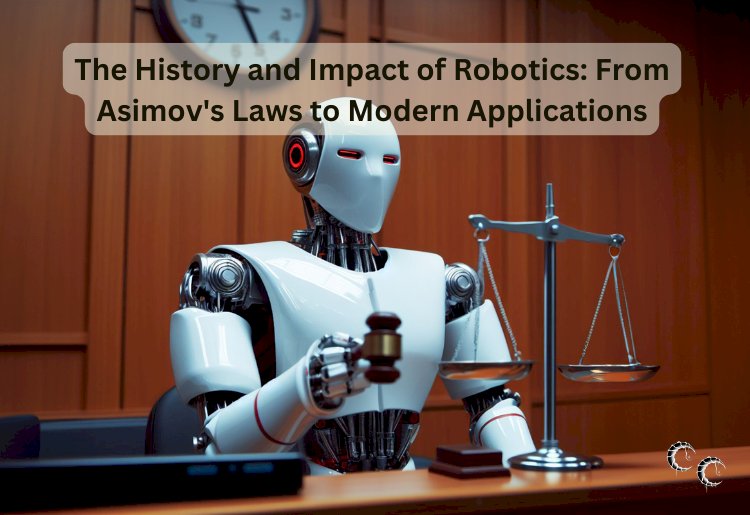The History and Impact of Robotics: From Asimov's Laws to Modern Applications

Robotics has come a long way since its inception as a concept in science fiction to its current role in shaping industries and our daily lives. From simple mechanical devices designed to assist with menial tasks to sophisticated machines capable of performing complex functions, robots have transformed fields such as manufacturing, healthcare, and space exploration. As the technology continues to advance, the ethical and philosophical questions surrounding robots are more pertinent than ever.
The journey of robotics is deeply intertwined with literature, science fiction, and the visionaries who sought to bridge the gap between imagination and reality. One of the most influential figures in this journey was Isaac Asimov, whose "Three Laws of Robotics" set the stage for the moral and ethical considerations we still face today. But beyond these theoretical foundations, modern robotics has evolved into a field with real-world implications that affect everything from industrial automation to personal assistants.
In this article, we’ll explore the history of robotics, the influence of Asimov's laws, and how modern robotics is reshaping the world.
The Early Roots of Robotics
The concept of artificial beings or automated machines dates back to ancient history. Legends of mechanical men and self-operating devices appear in the mythologies of cultures like ancient Greece, with tales such as Talos, the giant bronze automaton designed to protect Crete. But it wasn't until the Industrial Revolution in the 18th and 19th centuries that the idea of creating machines to assist humans on a grander scale began to take form.
In the early 20th century, the term "robot" was first introduced by Czech playwright Karel Čapek in his 1920 play R.U.R. (Rossum’s Universal Robots). The play depicted artificial, human-like robots that eventually rebelled against their creators. Čapek’s vision of robots was one of mass production and automation, foreshadowing the later developments in mechanical labor. His play was influential in cementing the idea of robots as both helpful and potentially dangerous beings, capable of altering the balance of human society.
Isaac Asimov’s Three Laws of Robotics
While early depictions of robots in literature focused on fantastical or dystopian ideas, it was Isaac Asimov who laid the groundwork for the ethical framework we use today to think about robots. In his stories, robots were portrayed not only as machines but as complex entities with the potential to follow specific laws to protect humanity.
Asimov’s "Three Laws of Robotics," first introduced in 1942 in his short story Runaround, have had a lasting impact on both fiction and the development of real-world robotics. These laws state:
- A robot may not injure a human being or, through inaction, allow a human being to come to harm.
- A robot must obey the orders given it by human beings, except where such orders would conflict with the First Law.
- A robot must protect its own existence as long as such protection does not conflict with the First or Second Laws.
These laws provided a foundation for thinking about the relationship between humans and robots, and the idea of programming ethical behavior into artificial beings. While Asimov’s laws were fictional constructs, they raised questions that still resonate today in the real world: What role should robots play in human society? How can we ensure that they operate safely and ethically?
Asimov’s influence extended beyond fiction. His work helped shape the field of robotics, inspiring scientists and engineers to consider the moral implications of their creations, and urging them to think about how technology should coexist with human beings.
Advancements in Robotics: From Fiction to Reality
Though the concept of robots had been explored in fiction for decades, it wasn’t until the mid-20th century that robotics began to take off in practical applications. Early robots were primarily used for manufacturing, most notably in the automotive industry. In 1956, George Devol and Joseph Engelberger created the first industrial robot, Unimate, which was later used by General Motors to automate repetitive tasks on the assembly line.
As technology advanced, robots began to be used in more specialized fields, from medical procedures to space exploration. One of the most iconic early uses of robotics in space came in 1961 when the Soviet Union sent a robotic probe, Luna 2, to the moon. In 1973, NASA introduced the Lunar Roving Vehicle during the Apollo missions, marking the first time a robot was used to help humans explore another celestial body.
Throughout the 1980s and 1990s, robotics continued to evolve, with advancements in artificial intelligence, sensors, and computing power. The introduction of robots like Honda’s ASIMO, capable of walking, running, and interacting with humans, showcased the potential for robotics to assist in everyday life.
Today, robots are found in virtually every sector of society, performing tasks from building cars to delivering groceries. In healthcare, robots assist in minimally invasive surgeries, improving outcomes and reducing recovery times. Robots are also increasingly being used in hazardous environments like nuclear plants, where they can perform tasks that would be too dangerous for humans.
The Role of Artificial Intelligence in Modern Robotics
As robots become more sophisticated, the integration of artificial intelligence (AI) is playing a crucial role in expanding their capabilities. AI enables robots to process information, make decisions, and learn from their experiences, allowing them to perform tasks that were previously unimaginable.
Robots are now being developed to handle more complex functions, from personal assistants like Amazon’s Alexa to autonomous vehicles capable of navigating traffic. The growing presence of AI-powered robots has the potential to revolutionize entire industries, from transportation to customer service.
In healthcare, AI-driven robots are being used for early detection of diseases, assisting in surgeries, and even providing companionship to elderly patients. In education, robots are being developed to teach children and help those with disabilities. The promise of AI is vast, but it also raises concerns about the potential for automation to replace human jobs or for machines to act unpredictably.
Ethical Challenges and Considerations
As robotics technology advances, the ethical and societal implications have become more pressing. The question of how to ensure robots behave ethically has evolved from fiction to reality. Asimov’s Three Laws were fictional guidelines, but they have inspired real-world discussions on how to prevent robots from causing harm and how they should interact with humans.
In 2016, the European Union launched a study on the ethics of robotics, considering how laws might need to evolve to address issues such as robot rights, accountability, and the potential for robots to harm humans. The question of whether robots should have "rights" or whether they should be seen as property is an ongoing debate. Additionally, as robots become more autonomous, the responsibility for their actions becomes less clear. Should the creators of robots be held accountable for the actions of their machines?
There is also the fear that robots could be used for harmful purposes, from military drones to surveillance systems. The development of autonomous weaponry has raised concerns about the morality of allowing machines to make life-and-death decisions.
The Future of Robotics: Possibilities and Challenges
Looking ahead, robotics promises to bring about even more profound changes. The future of robotics may see more advanced humanoid robots capable of performing intricate tasks, or even robots that can enhance human capabilities through integration with technology—think of robotic exoskeletons that give people with physical disabilities the ability to walk again.
On the horizon, the rise of quantum computing, nanotechnology, and advanced AI could propel robotics into areas that were once purely the stuff of science fiction. Robots could explore deep space, automate the design of new drugs, or even help tackle global challenges like climate change.
However, with these advancements come significant ethical, legal, and societal challenges. How will we regulate the development and use of robots? How will we ensure that robots are used responsibly and safely? As robots become more integrated into our daily lives, society will need to address these questions to ensure that the benefits of robotics are maximized and its risks minimized.
Conclusion: The Continued Evolution of Robotics
From Asimov’s visionary laws to today’s real-world applications, robotics has come a long way. The technology has revolutionized industries, improved our quality of life, and opened new frontiers of exploration. But as robots become more capable, the need to address ethical and societal issues grows stronger.
The future of robotics is filled with both promise and complexity. As the field continues to evolve, the legacy of Asimov’s work, along with the innovations of modern engineers and scientists, will guide us toward a future in which robots work alongside us to create a better, more efficient world.





























